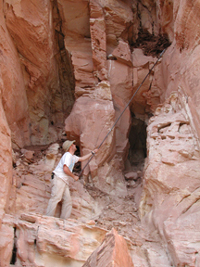 A study of ancient
rodent trash piles in Grand Canyon caves has confirmed that the American Southwest
experienced the climatic period known as the Younger Dryas — a cold snap
lasting from 12,900 to 11,600 years ago that has been documented in ice cores
and seafloor sediments in Greenland, Europe and the North Atlantic Ocean.
A study of ancient
rodent trash piles in Grand Canyon caves has confirmed that the American Southwest
experienced the climatic period known as the Younger Dryas — a cold snap
lasting from 12,900 to 11,600 years ago that has been documented in ice cores
and seafloor sediments in Greenland, Europe and the North Atlantic Ocean.U.S. Geological Survey researcher John Cannella attempts to knock down a 12,000-year-old packrat midden from an alcove in Utah. The packrat waste can serve as a proxy for vegetation changes over time and indicates that a cold snap 12,000 years ago, once thought to only affect the North Atlantic area, extended to the American Southwest. Image courtesy of Kenneth Cole.
“This study shows that the Younger Dryas climate change had a profound effect on ecosystems in the American Southwest,” says Geoffrey Spaulding, a paleontologist and senior scientist at CH2M Hill in Las Vegas, Nev., who reviewed the paper, which was published in the September Geology. “It wasn’t just a phenomenon that was restricted to the North Atlantic, as had been thought for decades.”
Kenneth Cole, a paleoecologist at the U.S. Geological Survey (USGS) Southwest Biological Center at Northern Arizona University (NAU) in Flagstaff, and Samantha Arundel, an NAU colleague, analyzed both fecal pellets and bits of agave plants from fossil packrat middens — piles of debris collected by rodents whose urine crystallizes to help preserve the untidy heaps. “The packrat is just a little sampling machine, going around eating all the plants surrounding where it lives, so the pellets should integrate all the components of its diet,” including preserving carbon isotope ratios, Cole says.
Plants with different photosynthetic pathways produce leaves with different carbon isotope ratios and also tend to grow in different habitats. For example, conifers such as juniper grow at higher elevations and produce lower carbon isotope values, whereas succulents such as prickly pear cactus and agave grow at middle elevations and produce a much higher range of values. Because packrats eat these plants, the carbon isotope composition of the packrat fecal pellets can show how the ranges of desert plants moved up and down in the past in response to changing temperatures, Cole says.
Cole and Arundel’s analysis reveals that the packrats were eating plats with lower carbon isotope values during the Younger Dryas, indicating that cooler temperatures forced higher elevation plants to move to lower elevations. To validate this trend, the researchers then looked at samples of undigested Utah agave plants from the same middens and found that, during the Younger Dryas, these plants also resided at much lower elevations. They used modern mass spectrometry, thus reducing errors in past radiocarbon dating, Cole says.
Previous studies of modern agave by Cole and others had established that the plant’s range is primarily dependent on how cold the weather gets in winter: It will not grow where the average minimum temperature in January is less than minus 8 degrees Celsius. Thus, applying the modern temperature proxy to the fossil agave record, Cole and Arundel found that during the last glacial maximum, around 17,000 years ago, the coldest winter temperatures in the Grand Canyon must have been about 8 degrees Celsius colder than at the same elevations today. Temperatures then warmed to as high as 4.5 degrees Celsius colder than today during the late glacial only to plunge back down to 7.5 to 8.7 degrees Celsius colder than today in the Younger Dryas. The climate, the researchers say, then warmed rapidly at the end of the Younger Dryas, rising 4 degrees Celsius between 11,800 and 11,500 years ago.
“This is remarkable detail that more or less matches in timing and magnitude the temperature changes inferred from oxygen isotope variations in the Greenland ice core record,” says Julio Betancourt, a paleoecologist with the USGS at the University of Arizona’s Desert Laboratory in Tucson. “The novelty of this study is the use of multiple and matching lines of evidence to decipher the history of winter temperatures.”
The severe cooling at the beginning of the Younger Dryas coincided with human occupation of the Americas and the extinction of large mammals. And the rapid warming at the end of the period is analogous to that predicted to occur in the coming century and a half, leading the researchers to suspect that future ecological changes may be similar as well. “The warming is the most important point,” Cole says. “It may tell us what’s in store for us.”
Sara Pratt
Geotimes contributing writer

